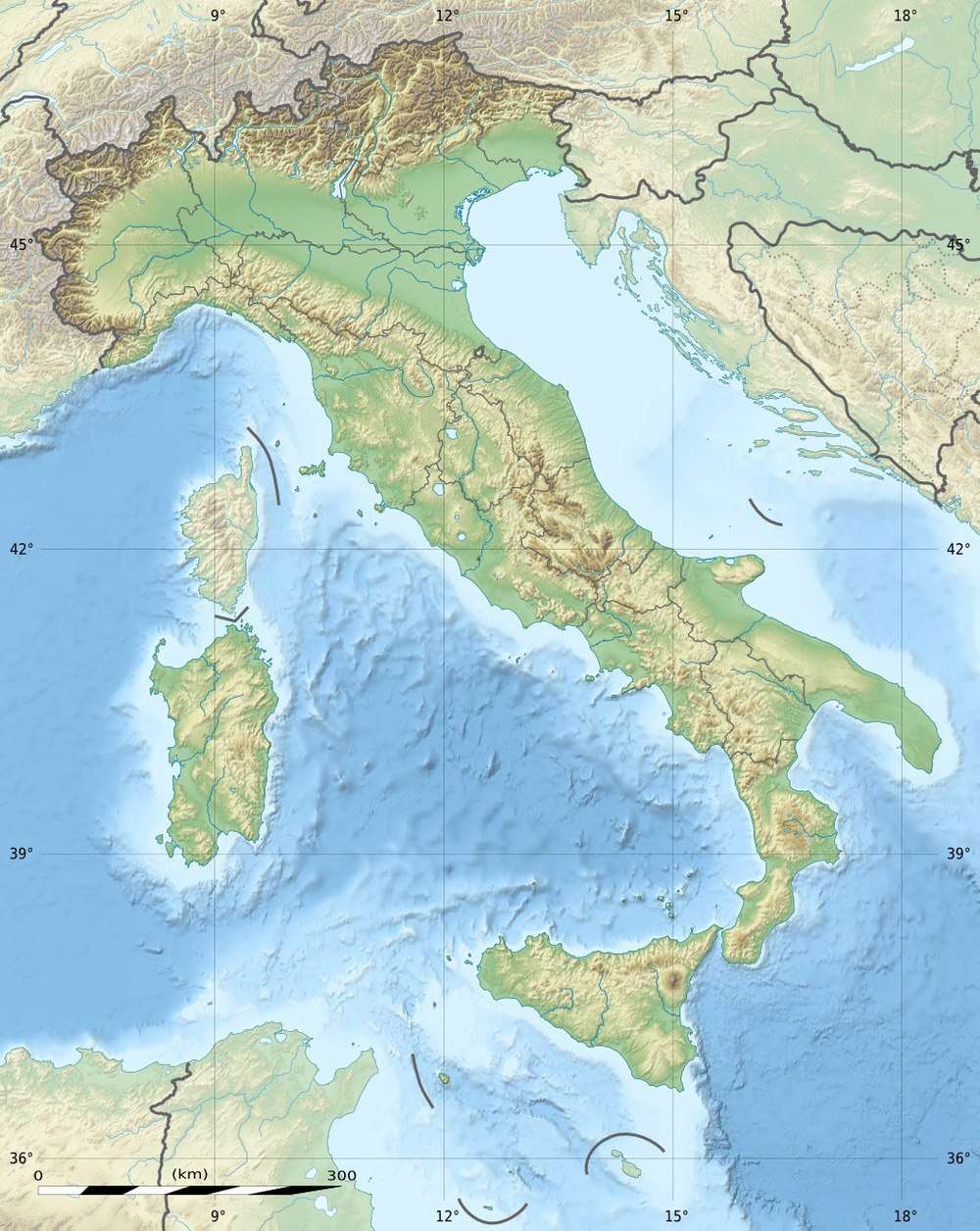Arene Candide
The Arene Candide, (Italian: Caverna delle Arene Candide, Cavern of the White sands) is an archaeological site in Finale Ligure, Liguria, Italy. Its name was derived from the eponymous dune of white (candida) sand (arena) that could be found at the base of the cliff until the 1920s in the Caprazoppa promontory, where the Arene Candide cave is located.
Caverna delle Arene Candide | |
 discovered fossils, now at Pegli archaeological museum | |
 location in Italy  Arene Candide (Italy) | |
| Alternative name | Grotta dei Frati |
|---|---|
| Location | Caprazoppa promontory, Finale Ligure |
| Region | Liguria, Italy |
| Coordinates | 44°9′42.48″N 8°19′35″E |
| History | |
| Periods | late Upper Palaeolithic |
| Associated with | prehistoric settlers |
| Site notes | |
| Archaeologists | Arturo Issel, Luigi Bernabò Brea, Luigi Cardini |
The cave is situated at 90 m (300 ft) above sea level on the upper margin of the former Ghigliazza stone quarry and has three wide openings that point towards the sea. Thanks to its position and to those openings the cave is well lit and relatively dry. It can be accessed from above within 30 minutes via a path from Borgio Verezzi.
History
The cave is locally known as Grotta dei Frati or Armassa, and received its popular name in 1864, when Arturo Issel visited it, who was the first in a long series of archaeologists and geologists and researchers.[1][2][3][4][5]
The Arene Candide gained international attention after the excavation campaigns in the years 1940 to 1942 and 1948 to 1950 in the south-eastern part of the cave, led by Luigi Bernabò Brea and Luigi Cardini.[6][7][8][9] Their excavation brought a detailed stratigraphic sequence to light, that ranges from the Upper Palaeolithic to the Byzantine period.[10] The favorable environmental conditions in the cave proved to be the key to the good state of conservation of the organic material like bone fossils and charcoal fragments. Due to their extraordinary preservation condition, the nineteen paleolithic burial pits, that were discovered in Arene Candide rank among the most significant funerary complexes in the world, as the material enabled researchers to conduct extensive and comprehensive anthropological studies in the framework of contemporary available scientific methods. Further excavations were carried out in the 1970s and the 2000s.[11][12]
The most remarkable and scientifically valuable burial is called the "Young prince" (Giovane principe), a juvenile male, around 15 years old, dated to about 23,500 years BP, attributed to the Gravettian culture.[13] The body was positioned on a layer of red ochre, 7 m (23 ft) below the surface sediment, looking to the South and accompanied by an extremely rich set of grave goods with a creel-like cap, jewels made of shellfish, animal bones, deer antler and a long (23cm) flint tool in his hand. The blade was crafted of flint originating in the Forcalquier basin in SE France. The fossil bears a mortal wound below its chin, that was tidied up with yellow ochre before the final burial. Isotope analysis of the teeth revealed that approximately ¼ of the juveniles diet consisted of marine protein[14]
Excavation discoveries are on display in several Italian museums, including the Museum of Ligurian Archaeology in Genoa Pegli, the Archaeological Museum of Finale in Finale Ligure and the Pigorini National Museum of Prehistory and Ethnography in Rome.
References
- Issel, Arturo (1864). "Di una caverna ossifera di Finale". Atti della Società Italiana di Scienze Naturali (in Italian). Milano (7): 173–185.
- Issel, Arturo (1886). "Scavi recenti nella caverna delle Arene Candide in Liguria". Bullettino di Paletnologia Italiana (in Italian). Parma: Tip. della Società fra gli operai tipografi. 7–8 (12): 112–133.
- Morelli, Nicolò (1890). "Resti organici rinvenuti nella Caverna delle Arene Candide". Atti della Società Ligustica di Scienze Naturali e Geografiche (in Italian). Genoa: Società Ligustica di Scienze Naturali e Geografiche (4): 273–317.
- Issel, Arturo (1892). Liguria geologica e preistorica (in Italian). con note e disegni originali di N. Morelli; panorami e fotografie di G. Dallepiane. Genoa: A. Donath.
- Issel, Arturo (1908). Liguria preistorica. Genoa: Società ligure di storia patria.
- Bernabò Brea, Luigi (1946). Gli scavi nella caverna delle Arene Candide (Finale Ligure). Parte I Gli strati con ceramiche (PDF) (in Italian). Bordighera: Istituto internazionale di studi liguri.
- Bernabò Brea, Luigi (1956). Gli scavi nella caverna delle Arene Candide (Finale Ligure). Parte I Gli strati con ceramiche. Vol. II Campagna di scavo 1948-50 (PDF) (in Italian). Bordighera: Istituto internazionale di studi liguri.
- Bietti, Amilcare (1994). The upper pleistocene deposit of the Arene Candide cave (Savona, Italy): new studies on the 1940-42 excavations. Rome: Istituto italiano di paleontologia umana.
- Maggi, Roberto; Starnini, Elisabetta; Voytek, Barbara (1997). Arene Candide : a functional and environmental assessment of the Holocene sequence : excavations Bernabò Brea, Cardini 1940-50. Rome: Il calamo. ISBN 88-86148-29-1.
- Pastorino, Anna Maria (1997). "Roman and Late Roman layers in the cave of Arene Candide". In Roberto Maggi (ed.). Arene Candide: a functional and environmental assessment of the holocene sequence (excavations Bernabò Brea-Cardini 1940-1950). Roma. pp. 623–634. ISBN 9788886148290.
- Tiné, Santo (1999). Il Neolitico nella Caverna delle Arene Candide (scavi 1972-1977) (in Italian). Bordighera: Istituto internazionale studi liguri. ISBN 88-86796-09-9.
- Binder, Didier; Maggi, Roberto (2001). "Le Néolithique ancien de l'arc liguro-provençal" (PDF). Bulletin de la Société préhistorique française. Société préhistorique française. 98 (98.3): 411–422. doi:10.3406/bspf.2001.12528. ISSN 0249-7638. Archived from the original (PDF) on 24 September 2015. Retrieved 12 May 2014.
- Hirst, Kris. "Arene Candide - Upper Paleolithic Burial of Arene Candide". about.com. Retrieved 23 August 2015.
- Pettitt, P.B.; et al. (2003). "The Gravettian burial known as the Prince ("Il Principe"): new evidence for his age and diet" (PDF). Antiquity. 77 (295): 15. doi:10.1017/S0003598X00061305. Retrieved 25 August 2015.